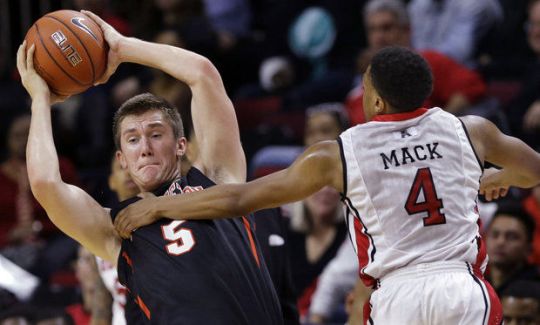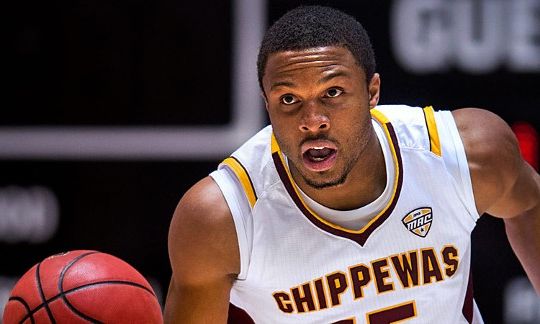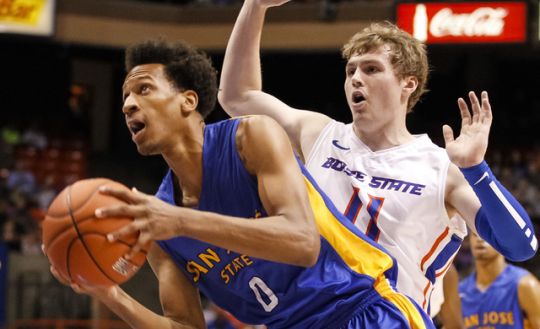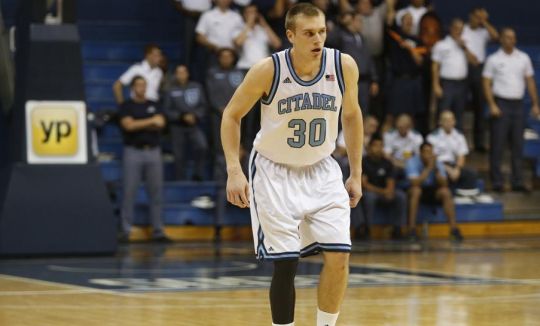We Salute You: Paying Homage to the Nation’s Winless Teams in League Play
Posted by Kenny Ocker (@kennyocker) on February 4th, 2014Kenny Ocker (@kennyocker) is a national columnist for Rush The Court and spent way too much time on these articles.
With the calendar turned to February and the meat of conference play upon us, the most dominant and least effective teams are showing their colors against equal competition. And with the halfway point of conference season rapidly approaching for many – and already here for others – now is a good time to take stock of both teams that are undefeated in conference and those who have yet to win a game. Today’s installment takes a look at the less fortunate teams among us, ranked from least to most likely to not win a game in conference play.
Note: All statistics dutifully harvested from kenpom.com.
Princeton (12-5, 0-3 Ivy League)

Although things have been a struggle lately for T.J. Bray and Princeton, the chances of the Tigers going winless is zero. (AP)
- Odds: 0.0 percent chance to go winless
- Most likely wins: February 8 at home vs. Cornell, 97 percent; March 7 at Cornell, 91 percent
- Biggest strengths: Top 15 in field-goal shooting, top 10 in defensive rebounding nationally
- Achilles’ heel: Field-goal defense in bottom 100 nationally
- Key player: Senior guard T.J. Bray (17.8 points per game, 5.7 assists per game, 55 percent field goal shooting; the nation’s most efficient player to use more than 20 percent of available possessions.)
- Outlook: Perhaps it’s not fair to start off with an Ivy League team, given that the Tigers are only three games into their conference slate. But few teams have had more surprising collapses than Princeton, which squandered a 9-2 non-conference slate and talk of a possible two-bid Ivy League by losing games against Penn, Harvard and Dartmouth. Here’s the thing: Each game was on the road; Penn is an ancient rival; Harvard has athletes unlike the conference has seen in a generation; and Dartmouth, well, there’s probably not a ready-made excuse for that one, although it did happen in overtime. To get an NCAA Tournament bid now, though, the Tigers have to sweep their next 11 games and hope the Crimson lose twice aside from the teams’ head-to-head February 22 matchup, and then beat them in a one-game neutral-site playoff. That’s a tall order, even for one of the nation’s best offenses, and the one that shoots more three-pointers than any other. But failing to win a game in the Ivy League is not in question here.
Delaware State (4-17, 0-8 Mid-Eastern Athletic Conference)
- Odds: 0.3 percent chance to go winless
- Most likely wins: February 22 at home vs. Maryland-Eastern Shore, 75 percent; March 1 at home vs. Howard, 66 percent
- Biggest strength: Top 125 nationally in blocked shots
- Achilles’ heel: One of the nation’s 10 worst shooting teams, including under 28 percent from three-point range
- Key player: Junior center Kendall Gray (11.1 points per game, 7.0 rebounds per game, top 25 in blocked shot rate)
- Outlook: Make no mistake from the Hornets’ low chance to go winless in the MEAC – they’re pretty bad and even more unwatchable, and that has cost coach Greg Jackson his job already. They’re among the nation’s 10 worst shooting teams on both two-point and three-point shots, and one of the nation’s 10 worst defensive rebounding teams, all the while playing at the nation’s second-slowest tempo. It’s fitting that the grind-it-out team’s best player is Gray, who has six double-doubles this season despite playing at such a slow tempo. Delaware State’s comparably high chances of winning a game in the MEAC come from the other conference cellar-dwellers, including Maryland-Eastern Shore, which is 1-6 thus far and has won only five total games in the past two seasons. The Hawks and Hornets still have to square off twice, but the first matchup isn’t until February 22.
Central Michigan (7-13, 0-8 Mid-American Conference)

A couple of home games in the coming week might get Chris Fowler and Central Michigan in the win column. (USA TODAY Sports)
- Odds: 0.3 percent chance to go winless
- Most likely wins: February 19 at home vs. Ball State, 77 percent; February 23 vs. Northern Illinois, 62 percent
- Biggest strength: Top 40 in two-point shooting
- Achilles’ heel: Nation’s worst block rate; teams shoot nearly 59 percent against them on two-point shots
- Key player: Sophomore point guard Chris Fowler (17.9 points per game, 4.9 assists per game, 56.1 percent field goal shooting; top 15 assist rate nationally)
- Outlook: The Chippewas should probably call Martha Stewart, because they need interior help. Despite the starting point guard Fowler being one of the most efficient players using more than 28 percent of a team’s possessions, there’s not enough height or size in the frontcourt to keep teams away from the basket and force tough shots. Starting sophomore forwards Blake Hibbits and John Simons both shoot 36 percent from three-point range and more than 50 percent on two-pointers, but at 6’7” and 6’8”, respectively, and neither over 230 pounds, it’s easy to say they’re miscast defensively and need a big body to deter opponents. Six of the Chippewas’ seven rotation players are sophomores or freshmen, which means coach Keno Davis is one or two big bodies away from a well-rounded, dangerous team. And with a guard as potent as Fowler, it only takes one hot game to carry his team to a win.
George Mason (7-14, 0-7 Atlantic 10 Conference)
- Odds: 1.1 percent chance to go winless
- Most likely wins: March 8 at home vs. Duquesne, 74 percent; February 26 at home vs. Richmond, 46 percent
- Biggest strength: Top 50 in defensive rebounding
- Achilles’ heel: In nation’s bottom 50 in turnovers, steals and two-point field goal defense; too many fouls
- Key player: Senior guard Bryon Allen (15 points per game, 3.1 assists per game, 38.1 percent three-point shooting)
- Outlook: For a team led by senior guards Bryon Allen and Sherrod Wright and coached by the same Paul Hewitt who took Georgia Tech to a championship game a decade ago, this season can’t be regarded as anything but a disappointment. They, along with sophomore guard Patrick Holloway, play most of the Patriots’ minutes in Hewitt’s three-guard system, and the lack of turnovers generated has to rest with them. In their defense, however, the team’s interior offense has been a turnover-attracting black hole, where the ball goes into the post but never finds its way into the basket. But rest easy, Mason fanatics: Your team came within one point of knocking off Massachusetts and took Rhode Island and conference leader Saint Louis to overtime, and you have more than a 40 percent chance of winning in five of your nine remaining games. This season should only end in relative ignominy, not full-scale ignominy.
UNC Wilmington (6-17, 0-8 Colonial Athletic Association)
- Odds: 3.1 percent chance to go winless
- Most likely wins: February 22 at home vs. College of Charleston, 46 percent; February 12 at home vs. Northeastern, 45 percent
- Biggest strength: Decent offensive rebounding rate
- Achilles’ heel: 46 percent two-point shooting, 26.5 percent three-point shooting
- Key player: Junior forward Cedrick Williams (14.0 points per game, 7.0 rebounds per game, 80.4 percent free-throw shooter at 6’9”, 225)
- Outlook: One group of traditionally moribund Seahawks just won a championship. This is not that group. This is a group whose brief blip in the nation’s conscience came after a barrage of Brett Blizzard bombs busted brackets back in 2002, beating fourth-seeded USC in the NCAA Tournament before losing to Indiana in the next round. UNC Wilmington is the nation’s second-worst team from behind the three-point line, and also one of the nation’s worst defensive rebounding squads, so it’s tough for them to get leads and even harder for them to come back from behind. Forward Cedrick Williams is the only Seahawk with an above-average offensive rating, which comes mainly from his strong free-throw shooting and effective short-range shots after getting offensive rebounds. And there’s plenty of those to go around in Wilmington right now. On the bright side, however, UNC Wilmington took conference leader Delaware to the wire in a one-point loss Saturday (though the Blue Hens were shorthanded due to suspensions), and there are still five home games left on the Seahawks’ schedule.
Grambling State (1-17, 0-9 Southwestern Athletic Conference)
- Odds: 9.8 percent chance to go winless
- Most likely wins: March 1 at home vs. Arkansas-Pine Bluff, 45 percent; March 3 at home vs. Mississippi Valley State, 39 percent
- Biggest strength: Not below average at forcing turnovers
- Achilles’ heel: Nation’s second-worst per-possession defense, last in field goal percentage against and fourth from last in defensive rebounding rate
- Key player: Junior forward A’Torri Shine (15.2 points per game, 75 percent free-throw shooting while shooting nearly twice as many free throws as his closest teammate)
- Outlook: The Tigers haven’t had a conference win since March 5, 2012, at the expense of Alabama A&M, but they are much improved from last year’s team, which had the worst offense and defense in the country and was seldom competitive. They still have the nation’s worst defense, though the numbers look much better (with the added benefit of half a season of SWAC play left to boost those numbers), and thanks to newcomers A’Torri Shine, Antwan Scott and Remond Brown, the offense is merely bad, not horrendous. But in the SWAC, that’s all you really need. The team with Division I’s smallest budget has come within two points of knocking off defending conference regular-season champion Texas Southern, and also only lost by one to Prairie View A&M and by two to Arkansas-Pine Bluff. With return games against each team, plus a game against fellow straggler Mississippi Valley State, there’s a good shot Grambling State sneaks out of this season without their 44-game Division I losing streak intact.
San Jose State (6-16, 0-10 Mountain West Conference)

Despite the outstanding play of Rashad Muhammad, there is a chance that San Jose State might not get off the zero this year. (AP)
- Odds: 10.7 percent chance to go winless
- Most likely wins: February 12 at home vs. Air Force, 51 percent; March 8 at home vs. Fresno State, 39 percent
- Biggest strength: Solid three-point shooting for a team that shoots more than anyone but Princeton
- Achilles’ heel: Terrible two-point shooting, can’t force turnovers (bottom 10 nationally in both categories)
- Key player: Freshman guard Rashad Muhammad (14.7 points per game, 41.8 percent three-point shooting, 84.6 percent free-throw shooting)
- Outlook: The Spartans’ cupboard was spartan as they made their football-related transition from the WAC to the Mountain West this season. One of the country’s least-experienced teams, San Jose State has struggled in most of its conference games, though it only lost by four to New Mexico, the league’s second-best team behind San Diego State. The freshman guard Muhammad has made his mark as a marksman early in his career, hitting more than 41 percent of his three-pointers, but he is the only above-average three-point shooter on the team. As for San Jose State as a team, they best make the best of this week’s shot at Air Force, because the Fresno State game at the end of the season is the only other one in which they have a greater than 30 percent odds of winning. But hey, San Jose State did something Connecticut couldn’t earlier this year: Win at Houston.
Illinois-Chicago (5-18, 0-9 Horizon League)
- Odds: 14.1 percent chance to go winless
- Most likely wins: February 21 at home vs. Oakland, 45 percent; February 18 at home vs. Detroit, 42 percent
- Biggest strength: Top 20 in defensive rebounding rate
- Achilles’ heel: Bottom 15 in blocks, bottom 50 in two-point field-goal defense
- Key player: Senior guard Kelsey Barlow (15.1 points per game, 5 rebounds per game, 4 assists per game; four single-digit scoring outputs in last six games)
- Outlook: The Flames, quite simply, can’t stop anybody inside, either by blocking shots or forcing bad ones, and that’s why they’re in this not-so-stellar position. UIC’s best player, guard Kelsey Barlow, has been up and down in Horizon League play, which is only exacerbating the situation of a tenuously built team. The Purdue transfer uses nearly 30 percent of his team’s possessions but shoots under 40 percent from the field, which is a bad combination, especially coming from the team’s offensive playmaker. UIC’s next two games are on the road at conference leaders Wisconsin-Green Bay and Cleveland State, but three of the Flames’ final four games are in Chicago, which will be their best shots to pick up their so-far-elusive first conference win.
Presbyterian (4-19, 0-8 Big South Conference)
- Odds: 14.9 percent chance to go winless
- Most likely wins: February 5 at home vs. Longwood, 51 percent; February 8 at home vs. Radford, 24 percent
- Biggest strength: In top 10 in keeping opponents off the free-throw line
- Achilles’ heel: Still have the nation’s worst per-possession defense, thanks to being 300th or worse at forcing turnovers, guarding two-pointers and three pointers, and grabbing defensive rebounds
- Key player: Junior guard Jordan Downing (19 points per game, 39.5 percent three-point shooting)
- Outlook: Presbyterian may be Best In Prayer (rearrange the letters and you’ll see), but they’ve been scrambled by opposing teams taking advantage of one of the nation’s shortest teams inside, with only one regular player over 6’5”. The Blue Hose have only been within five points of one Big South foe, Winthrop, in their eight conference losses. They only play eight players regularly, with nearly half of their lineups split between six players. Guard Jordan Downing plays more than 90 percent of his team’s minutes and leads them in scoring at 19 points per game. Presbyterian’s next two games are their best shots at wins; if the Blue Hose lose both games, they have four games on the road of six remaining.
The Citadel (4-20, 0-9 Southern Conference)

If the Citadel is to get in the win column, Matt Van Scyoc will likely play a big part in that. (Citadel Athletics)
- Odds: 21.8 percent chance to go winless
- Most likely wins: February 24 at home vs. Sanford, 33 percent; March 1 at home vs. Georgia Southern
- Biggest strength: Keeping teams off the free-throw line (it’s relative, but they’re 94th nationally)
- Achilles’ heel: No size; tallest regular player is 6’7”, which leads to poor interior scoring and worse two-point defense
- Key player: Sophomore forward Matt Van Scyoc (15.1 points per game, 5.1 rebounds per game, 87.5 percent free-throw shooter)
- Outlook: The South Carolina military school has come close to five Southern Conference wins, including two overtime games on the road, but it still hasn’t come away with a win. With the Bulldogs’ conference schedule more than half over, time is ticking on getting the W they’ve missed out on so far. The good news for The Citadel is that it doesn’t have a senior in its rotation. The bad news for coach Chuck Driesell, son of the famous Lefty, is that his team’s best two chances for wins come in their last two SoCon games, so there could be another month’s worth of waiting before this resolves.
Southern Utah (1-18, 0-10 Big Sky Conference)
- Odds: 24.4 percent chance to go winless
- Most likely wins: February 20 at home vs. Portland State, 23 percent; February 22 at home vs. Eastern Washington, 23 percent
- Biggest strength: Deepest team in nation in terms of bench minutes played
- Achilles’ heel: One of the nation’s five worst shooting teams from two-point range, one of nation’s 10 worst teams at free throws conceded
- Key player: Freshman point guard Trey Kennedy (10.6 points per game, 2.5 assists per game, 27.5 minutes per game; each leads the team)
- Outlook: Southern Utah’s statistics probably don’t do justice to the odds of them winning a game. Early blowouts in each non-conference game – none was closer than 15 points – from a team that came in with 10 combined varsity seasons among its 13 players mask a team that has come within single digits of six Big Sky foes, including in each of their last five games. In fact, the Thunderbirds’ most recent game, Saturday night against Montana State, they came within a blocked three-pointer as time expired to a win. And each of the six teams against which they have played still have to play them again, including four that will be played at home in Cedar City. A win is coming. Just wait.
Cornell (1-17, 0-4 Ivy League)
- Odds: 25.2 percent chance to go winless
- Most likely wins: February 14 at home vs. Dartmouth, 22 percent; March 8 at home vs. Penn, 30 percent
- Biggest strength: A not-below-average turnover rate
- Achilles’ heel: Worst team in the nation at getting to the free-throw line; nation’s third-worst defense
- Key player: Sophomore guard Nolan Cressler (16.3 points per game, 4.6 rebounds per game)
- Outlook: Good news, Big Red fans! You have two games remaining against a team winless in conference. Bad news is, they’re against a Princeton team favored 10-to-1 in both games, including the one in Ithaca, N.Y. The halcyon days of yore in which Cornell went 13-1 in conference play in 2009-10 seem so distant; the team that once led the nation in three-point field goal percentage is now 313th, the nation’s fourth-ranked offense now in 264th. The conference slate could be a slog until Penn pays a visit to Cornell in the teams’ final Ivy League game, with a pair of games against both Princeton and Harvard remaining. This looks like a long winter.
Texas Christian (9-11, 0-8 Big 12 Conference)
- Odds: 27.6 percent chance to go winless
- Most likely wins: February 12 vs. Baylor, 25 percent; March 8 vs. Oklahoma, 20 percent
- Biggest strength: Good at getting to the free-throw line and just as good when they get there
- Achilles’ heel: Equally awful at offensive and defensive rebounding, in nation’s bottom 50
- Key player: Junior point guard Kyan Anderson (15.3 points per game, 4.7 assists per game)
- Outlook: The Horned Frogs aren’t above pulling off a surprise, as they did last season in beating a Kansas team that was 19-2 and undefeated in Big 12 play at the time. But this year’s situation seems even more desperate than last year’s. There’s little talent surrounding point guard Kyan Anderson, at least in Big 12 terms – some smaller schools would gladly take the athletes coach Trent Johnson has stockpiled – but worse are the opportunities already squandered. Both games against Texas Tech, a solid ninth in the 10-team conference, have already been lost, as have home games against Kansas State and West Virginia. That’s why TCU’s two “best” shots at conference wins are against Baylor and Oklahoma teams that have both been ranked in the AP poll in the last month. It’s a recipe for disaster when your school has a down year during the conference’s best season in the better part of a decade.
IUPUI (5-19, 0-7 Summit League)
- Odds: 35.7 percent chance to go winless
- Most likely wins: February 15 at home vs. South Dakota, 31 percent; February 22 at home vs. IPFW, 19 percent
- Biggest strength: Relatively low turnover rate, good from the free-throw line
- Achilles’ heel: One of nation’s five worst offensive rebounding teams, coupled with bottom-50 field goal shooting
- Key player: Senior guard Ian Chiles (15.9 points per game, 3.5 rebounds per game, one broken right metacarpal)
- Outlook: The Jaguars face the exact opposite statistical bias of Southern Utah: They’ve lost each conference game by 15 or more points, and now are without the services of leading scorer Ian Chiles after he broke a bone in his right hand in late January. For a team that fans were already doubting the effort of, one that was struggling to score and rebound inside, losing their best outside threat is only going to compound that problem. Summit League play is already half over, and only three home games remain for IUPUI to collect a conference win. And long term, four senior rotation players exhaust their eligibility after this season, including Chiles, so next year could be an even bigger struggle.









































